|
Brownhills lies at the
north-eastern corner of Walsall, which it became part of
in 1974. It is believed that its name came from the plentiful
spoil heaps that once covered much of the area, as a
result of the many coal mines that were part of the
town's
large-scale mining industry. The Brownhills name has
been in use for at least 340 years. It is marked on Robert Plot’s map
of Staffordshire from 1680 as ‘Brownhill’. At that time
it was part of the Manor of Ogley Hay, that was part of
Norton Canes.
The A5 which follows the ancient
Roman road, Watling Street, runs through the northern
part of the town, where a burial mound called Knaves
Castle once stood. It provided evidence of early
settlement in the area and could have been of Roman
origin or earlier. |
|
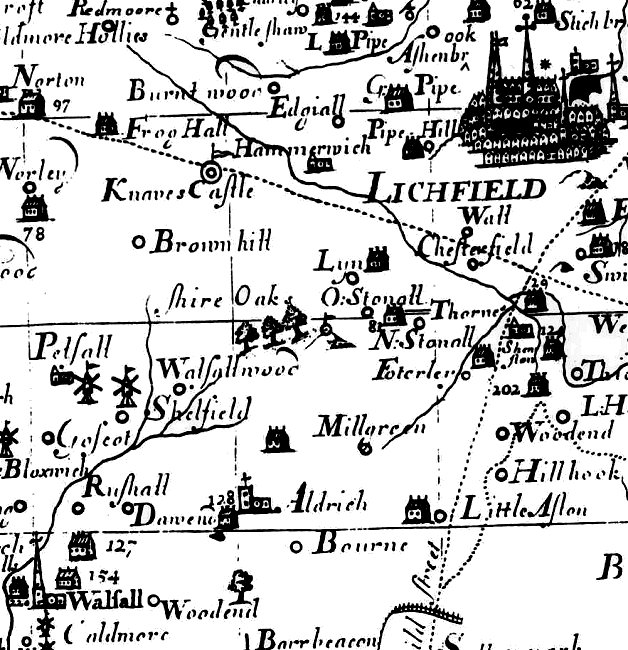
Part of Robert Plot’s map of
Staffordshire from 1680. |
|
Ogley Hay has links with
Wolverhampton because it was given to the town by
Lady Wulfrun as part of her grant to the Monastery
of St. Mary in 994. After the Norman Conquest it was
owned by the Canons of Wolverhampton as part of the
Deanery manor, before becoming Crown property in the
13th century. The name Ogley Hay is derived from the
Saxon name ‘Oogs's Leah’ or ‘Ocga Leah’ meaning a
clearing in a wood.
The area consisted of heathland
and woods, and formed part of Cannock Forest. Much
of the local forest was cleared in the 15th and 16th
centuries for the grazing of sheep, which encouraged
the spread of heather and led to the creation of a
huge area of heathland.
In
1765 a warrener named Richard Gildart bought the
Catshill area for use as a rabbit warren. Warren
Place and the Warreners Arms pub were named after
it. The Warreners Arms, on the corner of High Street
and Ogley Road, was built in 1871 and closed in 1999
when it became a McDonald's restaurant, which closed
in 2004. In the 1930s the Brownhills Early Closers
football team who were in the Walsall and District
Thursday league, played at the rear of the Warreners
Arms. The local geology consists
of sand and red clay deposits, overlying Triassic
sandstone and seams of coal. The coal seams on the
western side of the town around Brownhills Common
are much nearer to the surface than those to the
east, which in the 17th century led to the opening
of many shallow mine workings. As the demand for
coal increased, more mines opened, so much so that
the coal mines began to dominate the local area.
In the 17th and 18th centuries, road transport
was difficult because many roads were simply dirt
tracks that were almost impassable during wet
weather, especially for heavy loads. The problems of
transporting coal from the mines were eased with the
opening of the Wyrley & Essington Canal in 1797. The
canal was built to link the local coalfields to the
Birmingham Canal at Wolverhampton.
An Act of Parliament was passed
on 30th April, 1792 to allow the work to commence.
Much of the finance came from Wolverhampton
businessmen, principally the Molineux family. Work
soon started under the canal company's engineer,
William Pitt. There were two branches, one to a
colliery at Essington and the other to Birchills
near the centre of Walsall. The canal joined the
Birmingham Canal at Horseley Fields, Wolverhampton
and opened on 8th May, 1797. The work included the
building of Chasewater reservoir which was built as
a canal feeder reservoir. Because the canal followed
the contour of the land, locks were unnecessary and
so some of the canal boats were wider then usual, as
they didn't have to pass through narrow locks. They
were unique to this canal and were known as 'Amptons'
after their destination, Wolverhampton. Being a contoured
canal and following an extremely circuitous route,
it became known as "The Curly Wyrley".
A horse-drawn tramway was built in the early 19th
century to link some of the coal mines with the
canal wharves. The larger mines included Brownhills
Colliery, Conduit Colliery, Coppice Colliery,
Watling Street Colliery, and Grove Colliery.
Many of the local miners lived on Wolverhampton
Lane, which is now Pelsall Road. |
|
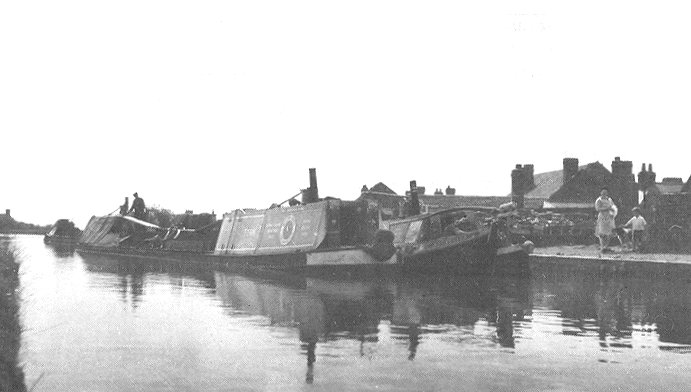
The canal at Brownhills in the 1960s. From an
old postcard. |
|
Old Chester Road (now High Street) became a turnpike
road in 1759,
with a toll gate and toll house at Anchor Bridge.
The road became known
as the Old Chester Turnpike Road.
The Anchor
Inn was built around 1796 and Watling Street was
vastly improved by Thomas Telford.
The toll house at Anchor Bridge was demolished in
1910 when the road was widened. |
|
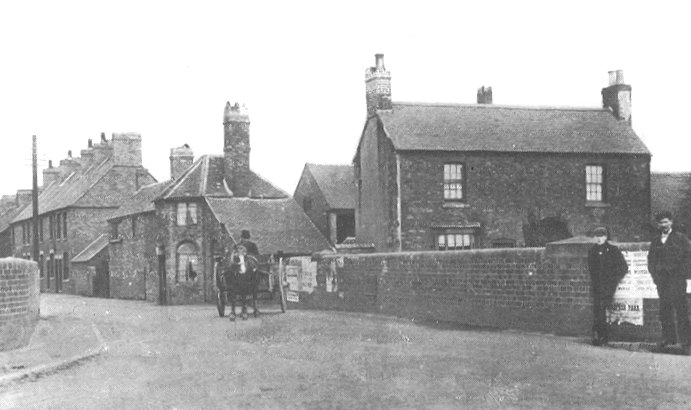
The toll house and Anchor Bridge. From
an old postcard. |

Part of the Brownhills entry
in William White's History, Gazetteer and Directory
of Staffordshire from 1834. |
In the 1801 census, Brownhills
is listed as having a population of only eight
people. In the early years of the century the number
of coal mines increased, spreading towards Watling
Street and the Rising Sun pub, which closed in 2008
and was demolished a few years later after an arson
attack. Many of the collieries
belonged to William Hanbury of Moreton House, and
William Harrison of Norton Hall.
Much of the land in the area
belonged to the Hussey family, who were Lords of the
Manor of Norton Canes. In 1836 on the death of
Phineas Hussey, Charles Foster Cotterill, a
merchant, who was appointed as a Capital Burgess of
Walsall in 1832 and became mayor of Walsall in 1834
and 1835, purchased the manor of Ogley Hay. In 1838
the heathland, which covered about 1,000 acres, was
enclosed and sold for uses including farmland and a
flour mill, which opened in 1839 and closed in 1942.
The last piece of land was sold in 1846.
|
|
The principal freeholders of the land were John
Nicholson, of Liverpool; William Stubbs; William
Middleton; and Messrs. G. and J. Brawn. |
|

From the Brownhills entries in
William White's History, Gazetteer and Directory of
Staffordshire from 1851. |
|

From Harrison, Harrod &
Company's 1861 Directory and Gazetteer of
Staffordshire. |
|
The population rapidly grew. In
1831 there were 24 people living in the area, which
increased to 221 in 1841. In 1861 there were 1,357
inhabitants and in 1871 the number had increased to
1,824.
Brownhills' first railway
station was on the north western side of the large
traffic island, where the coal miner statue now
stands. It was behind where 'The Smithy's Forge' bar
is today, at the end of Lichfield Road. The station
was originally on the 17¼
miles long section of the South Staffordshire
Railway between Walsall and Winchnor that opened on
9th April, 1849. There were also stations at
Walsall, Rushall, Pelsall, Hammerwich, and
Lichfield. From 1850 until 1871 the line was leased
by the engineer John Robinson McClean with a head
office at Lichfield, although he worked from
Walsall.
It became part of the London & North Western
Railway, and by 1906, 21 trains a day ran in each
direction through the station. Brownhills Railway
Station closed in 1965 as a result of the Beeching
Report, although the line continued in use for goods
until 1983.
|
|

Brownhills railway station in London and North
Western Railway days. From an old postcard. |
|
McClean also engineered the GWR
broad gauge line from Birmingham to Wolverhampton,
was the originator and engineer of the South
Staffordshire Waterworks Company, builder of the
Anglesey Branch Canal, and owner of several coal
mines near Chasewater. The Anglesey Branch Canal was built in
1800 as a feeder to carry water from Chasewater
Reservoir to the Wyrley and Essington Canal at Ogley
Junction, just south of Lichfield Road. In 1850 it
gained navigable status and was used to transport
coal from many of the mines in the area. It became
part of the Birmingham Canal Navigations in 1840.
Brownhills other railway station, which was on
Chester Road North, stood on the Brownhills Branch
from Aldridge to Norton Canes, where it joined the
Cannock Chase and Wolverhampton Railway, and also
several colliery lines. The section from Aldridge to
Walsall Wood opened in 1876, followed by the opening
of the section to Cannock in 1880. It was on the
Midland Railway and opened for
passengers in 1884. The station closed in 1960. Few passengers used the line,
which was built mainly for coal trains from the many
nearby pits. |
|

Brownhills Midland Railway station. From
an old postcard. |
|
Another
ex-railwayman ,William Roberts, who had worked in a
pit before becoming a navvy on the railway, acquired
a number of properties in the area including public
houses and farms. He became wealthy on the proceeds
and became Chairman of the Council and a local
magistrate. He was also a great benefactor in the
local area until his death in 1906. His obituary in
the
Lichfield Mercury, Friday 9th February, 1906 reads
as follows:
|
Death of Mr.
W. Roberts, J.P., of
Brownhills
A Remarkable
Career
We very
much regret to announce the
death of Mr. William
Roberts, J.P. of Brownhills
which took place early on
Monday morning at his
residence the Station Hotel.
The deceased gentleman, who
was seventy seven years of
age, had only been confined
to his bed since the new
year, though he had been
ailing for some time
previously. The deceased had
been attended by Dr. J. C.
Maddever.
The
deceased career was a
somewhat remarkable one.
Born in a humble station of
life, he had, by his own
perseverance and dogged
tenacity, built up an
extensive licensing business
and owned one of the largest
concerns in the brewing
trade under private
proprietorship in the
Midlands. The son of a
Waterloo veteran, he was
born at Shenstone near to
the Bulls Head Inn, in 1828.
From here, however, he
removed in infancy, his
father going to reside at
Brownhills at a farmhouse,
now known as the ‘Tommy
Shop.’ As a boy he assisted
his father upon the farm,
and also worked for some
time at the local
collieries. It was here that
he started his career as a
navvy on the new line then
being made from Walsall to
Lichfield, but, displaying
abilities far above the
average, he soon rose to the
position of a ganger.
On the
completion of the line he
went to Durham, where he
executed several contracts
in connection with railways,
which at that time, were in
their infancy. He had a
large number of men under
his control, and amongst the
railway contracting, in
which he took a large share,
was the erection of the
Stannidge Tunnel, between
Stalybridge and
Huddersfield, which is
between three and four miles
long. At this time he did a
large amount of work in
Lancashire and the north.
While in this part of the
country he became acquainted
with his future wife, Miss
Ann Bradley, the daughter of
a shoemaker, whom he married
at Yarm, in Yorkshire in
1852, and who survives him.
On the death of his father
he made his first venture in
the licensed trade at the
Tower Inn, Potter's Hill,
Aston. He, however, only
remained here about nine
months, and in 1860 he heard
from an old inhabitant of
Brownhills, Mr. Joseph
Marklew that the Station
Hotel was vacant. Mr.
Roberts immediately came
over, and satisfactory
arrangements being made with
the late Mr. Harrison, of
Aldershaw (Capt. W. B.
Harrison's father), he first
became the tenant of the
house and eventually bought
it.
At that
time the hotel had nothing
like the accommodation which
it now possesses, but as the
district became more
populous and business
increased, the house had
from time to time to be
enlarged. It is a curious
coincidence that the
deceased gentleman first
entered as tenant of the
Station Hotel on February
4th 1860, and died on
February 5th, 1906, forty
six years almost to the very
day.
Mr.
Roberts owned no fewer than
twenty six licensed houses,
all within a six mile radius
of Brownhills. These
included, in addition to the
Station Hotel, where he
resided up to the time of
his death, six other houses
in Brownhills, viz., the
Shoulder of Mutton, the
Royal George, the Wheatsheaf,
the Warrener's Arms, the
Swan Inn, and the Rising
Sun. He also owned the
Anglesey Hotel and the Globe
Inn, Hednesford; the Crown
Inn, Chadsmoor; the Crown
Hotel and the Swan Inn,
Cannock; Bridgtown Tavern,
Bridgtown: Swan Inn, Wyrley;
Freemasons' Arms, Newtown;
the Spotted Cow Inn and the
Spring Cottage, Bloxwich;
the Newport Arms; the
Elephant and Castle, and the
Vine Inn, Walsall; the Boot
Hotel, Walsall Wood; the
White Lion, Pelsall; the
Star Inn, Burntwood; the
Vine (outdoor beer license)
and the Yew Tree Inn,
Norton; and the Muckley
Corner Hotel, Muckley
Corner. For the Anglesey
Hotel at Hednesford the
deceased paid £12,100, for
the Spotted Cow Inn at
Bloxwich, £8,000; and for
the Vine Inn, Walsal1,
£6,000; the average price
paid for the remainder being
about £3,000.
Mr.
Roberts also owned a large
amount of private and
business property in
Brownhills and district. In
addition to his licensing
business, the late Mr.
Roberts took a keen interest
in agriculture, and was a
large breeder of cattle, and
especially of pigs. He was
the owner of three large
farming estates, including
the Pipe Place Farm, of 300
acres; the Warren House
Farm, of 90 acres; and the
Lodge Farm, of 65 acres.
Mr.
Roberts bad been identified
with the public life of the
locality for a very long
period. He was first elected
a member of the old
Brownhills Local Board in
1877, and sat continuously
until 1894, acting as
Chairman in 1892, 1893 and
1894. After an absence of
three years, he was elected
at a bye-election to a seat
on the Urban Council, as it
then was. In 1904 he was
again appointed Chairman,
succeeding Mr. J. Lloyd, and
being re-elected in 1905, he
thus held the office at the
time of his death.
He took
a deep interest in all the
affairs of the Council, and
was ever prominent in
bringing forward schemes for
the benefit of the
ratepayers. He had no doubt
to contend with much
opposition at times, but
having once formed his
opinions he maintained them
both inside and outside the
Council Chamber.
Particular mention should be
made of his work in
connection with the sewage
farm. He was a regular
attendant at the ordinary
and committee meetings of
the Council, nothing but
illness preventing him from
being present. He took a
prominent part in the
erection of the Public
Buildings at Brownhills in
1887 and in 1898 gave a
steam fire engine to the
District Council. From time
to time he made handsome
donations to various local
authorities charities
including two donations of
£100 each to the Walsall
Cottage Hospital, £100 to
the Hammerwich Cottage
Hospital, £105 to the
Wolverhampton General
Hospital, £100 to the Royal
Orphanage, Wolverhampton;
£100 to the Queen’s
Hospital, Birmingham; £100
to the General Hospital,
Birmingham; £25 to the
Wolverhampton Eye Infirmary;
and £25 to the Birmingham
Eye Hospital.
During
the great coal strike in
1893 be supplied free meals
daily to a large number of
the local strikers who were
destitute. He also
entertained the old people
and others upon the occasion
of the King’s, Coronation,
and at other times the
inhabitants of the locality
enjoyed his hospitality.
In
politics the deceased was a
staunch Conservative, and at
one time occupied the
position of Chairman of the
local Association. He was
also a Churchman, and
formerly held the office of
warden at St. James' Parish
Church. He also gave a
portion of the site upon
which the Mount Zion
Primitive Methodist Chapel
is now erected. The deceased
was a great believer in the
Friendly Society Movement,
and was a member of most of
the local lodges including
the Oddfellows, the Royal
Antediluvian Order of
Buffaloes, the Foresters,
the Free Gardeners, and many
others.
Immediately the death of Mr.
Roberts was announced, the
flag at the Public Buildings
was hoisted half-mast high,
and everywhere there were
signs of the respect in
which the deceased was held.
Much sympathy is expressed
with the widow. The funera1
will take place at St.
James’ Church this morning
at half past eleven o'clock. |
|
|
| After the opening of Brownhills first
railway station in 1849, there was a great
expansion in the local mining industry and an
increase in the population. The many new pits
included Cannock Chase Colliery, which opened in
1856; Walsall Wood Colliery, which opened in
1876; and
Wyrley No. 3 Pit, that opened in 1896. Many of
the miners lived in the Ogley Hay area, which
led to the development of the town centre. In
1878 Watling Street School opened,
followed by Brownhills Gas Works in 1880, the
Council Building in 1882, and the formation of
Brownhills Urban District consisting of Ogley
Hay, Shire Oak, Walsall Wood, and Norton Canes.
In 1896 the population was 12,500.
Local
government began in the form of vestry meetings
at St. James Church, where a number of local
officials were elected including the
first Constables, Overseers of the Poor, Rate
Collectors and a Surveyor of Highways.
The vestry was superseded by
Brownhills Local Board of Health, formed in 1877
when
the town of Brownhills was officially recognised
for the first time after becoming a Local
Government District on 29th September, 1877.
This happened
under the terms of a new Act that authorised the
amalgamation of rural districts into larger
local government areas. The locally elected
council's
first meetings were held in the School
Board offices, owned by Mr. Roberts, in High
Street,
until 1882, when the Council Building, in
Chester Road North, with its distinctive clock
(added in 1911), opened. The first election
resulted in a great deal of dissatisfaction
because six of the nine candidates came
from Norton Canes. In all future elections the area
was properly divided into wards.
In 1881 the Local Board decided to build the
Council Building and took out a loan of £2,000
to cover the cost. The building opened in 1882.
One of the distinctive features of the building
is the large clock on the front, which is made
of copper, porcelain, and decorated with gold
leaf. The coronation of King George V took place
in 1911 and the council's Coronation Committee
were left with a surplus of £19.5s.5d. which was
put towards the purchase of the clock. Further
funds were raised, including £3.4s.0d. from Mr.
Twigden's electrograph, which had been used on
the Wakes ground. The clock, which cost £95 was
restored in 1951 for the Festival of Britain
celebrations. The building remained in use by
the council until 1966 when the Aldridge and
Brownhills Urban District Council was formed. It
then became offices for a construction company
and now houses Brownhills library, Holland Park
Surgery and Lloyds Pharmacy. |
|
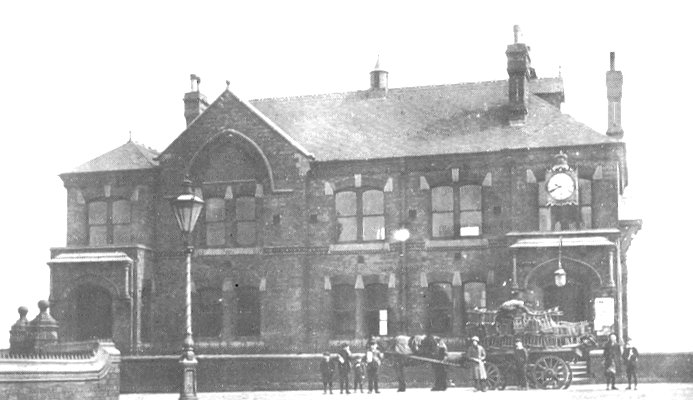
The Council Building with its decorative
clock. From an old postcard. |
|

Another view of the Council Building.
From an old postcard. |
| Brownhills Fire Brigade was formed in 1898 when
Mr. William Roberts, J.P. gave a Merryweather
fire engine to the council, which was pulled by
two of his brewery horses. The fire brigade was
manned by volunteers, and the fire engine was
kept in the yard behind the Council Building.
Initially the brigade was summoned by a bell on
the Central School, which was superseded by a
bell on the Council Building that also rang the
chimes on the clock. Churches
In 1838
Ogley Hay became a parish, although it was without a
parish church until the building of St. James
Church in 1850 -1851. In the late 1840s the local
population greatly increased and so it was decided
that a parish church was urgently required. The
matter of providing funds for a church was
considered at a meeting held in the Ogley Hay
schoolroom on 10th December 1849, attended by local
landowners and businessmen. A proposed site was
inspected and a building committee was formed,
consisting of the Rev. James Downes, J. Brawn, W.
Hanbury, W. Stubbs, W. Middleton, Round, Chawner,
Naden, Bannister, Smith and Stevens.
Funds were soon raised and the church was
designed by G. T. Robinson of Wolverhampton. In 1850
tenders were received from several companies for the
building of the church, which was carried out by
Hardwick & Son, of Birmingham, for £1,150 plus a
further £37 if the ceiling had to be boarded. Funds
amounting to £3,570 were given by the Lichfield
Diocesan Society, the Incorporated Church Building
Society, many organisations and private
individuals. The foundation stone was laid by
Viscount Lewisham, on August 22nd, 1850, and the
building was consecrated by the Rev. John Lonsdale
of Lichfield on Wednesday 15th October 1851.
St James Church originally consisted of a
chancel, a nave without aisles, and a small tower at
the western end with three bells and chimes, and
seating for 388 people. The first service was given
by the Rev. James Downes on Sunday, 19th October,
1851. On 19th December, 1851 James Downes performed
the first recorded burial service there.
A vestry meeting was held on 3rd July, 1854 to
discuss the erection of a parsonage. Those present
were the Rev. James Downes, W. Middleton, W. Stubbs,
J. Brawn and W. Hanbury. Land for the building had
been given by J. Nicholson, of Liverpool and plans
had been drawn up by the architect Mr. G. T.
Robinson, of Wolverhampton. The building, which was
expected to cost around £860 was built by Hardwick &
Son, of Birmingham, behind the church in Vicarage
Road.
James Downes continued until 1857 as Officiating
Minister. The first curates were the Rev. H.
J. Brookman, 1856-1857 and the Rev. Thomas Jackson,
1858-1860. At the turn of the century,
the Parish of Ogley Hay became the Parish of Ogley
Hay with Brownhills.
After the
First World War the cenotaph was built in the
graveyard and dedicated by the Bishop of
Lichfield, John A. Kempthorne. In 1956 the church
acquired the church hall, which officially opened on
6th October, 1956.
|
|
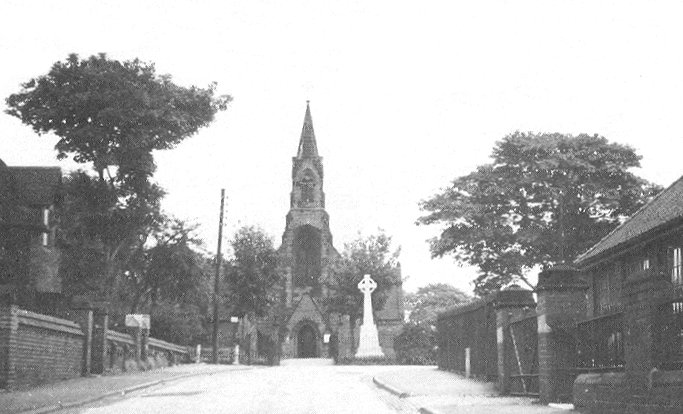
Looking along
Church Road towards St. James Church.
From an old postcard. |
|
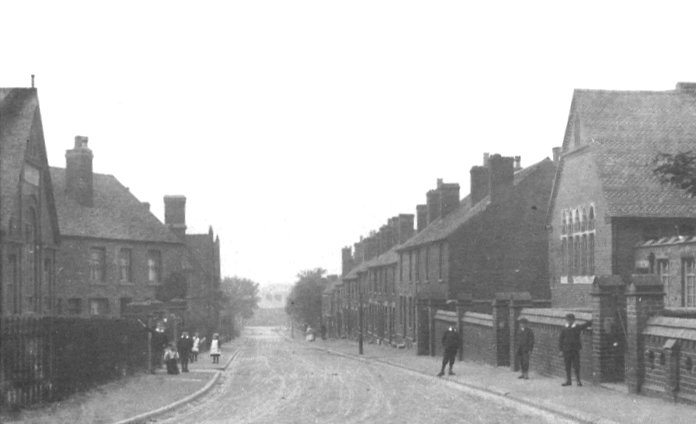
A 1912 view of
Church Road. From an old postcard. |
| The church had two mission churches, The Good
Shepherd at Muckley Corner, built in 1880 (closed in
1968), and the Church of St. Thomas, built on the
south side of Watling Street in 1874, and closed on
24th November 1973. The Independents and Primitive
Methodists also built chapels in 1820 and 1840
respectively. Schools
The Central Schools, Brownhills
Bridge, Brownhills, was designed by G. H. Cox and built
in 1893 in Queen Ann style, of orange brick with orange
terracotta and stone dressings. Inside the front porch
is a plaque carrying the names of the first members of
the school board. It was a mixed school until 1932 when
the girls moved to new premises in Great Charles Street.
The school was originally designed for 210 boys and
girls, and 120 infants and was later known as The
Annexe. In 1972 it became a comprehensive school and
then closed in 1980 when Brownhills School, on the
opposite side of Holland Park opened. The Girls High
School also moved there at the same time.
The substantial building alongside Pelsall Road, which
was added later, became the senior boys school. Finally
a third building was added to join the two buildings
together. After closure in 1980 the site was put on the
market by the council with a selling price of £600,000. At
the time it was hoped that the site would be sold and
the building demolished and replaced by apartments.
Luckily the Brownhills Local Committee objected to the
plan because of the building's local historical importance. As a result, the council
locally listed the building which secured its future.
The building was then refurbished and is now Brownhills
Community Centre and Street Riders Motorcycle Training
Limited. The community centre is a self-supporting
enterprise that provides education, recreation and
leisure facilities for the general community.
|
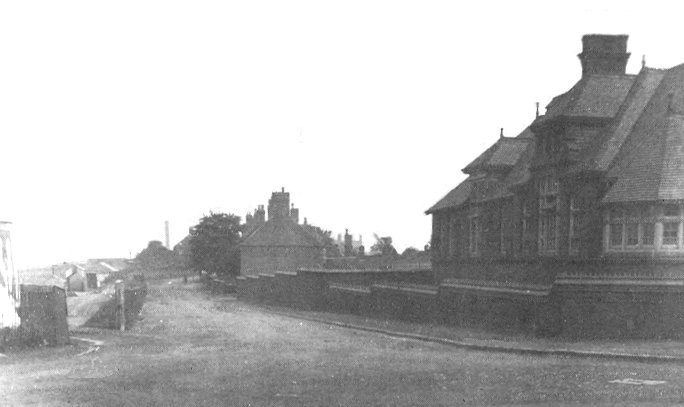
Looking along Pelsall Road with Central
Schools on the right. The photo was taken before the building
alongside the road was built. From an old postcard. |
|
Brownhills School is the town's main secondary
school. It formerly had several names: Brownhills Sports
College, Brownhills Community Technology College,
Brownhills Community School, and Brownhills
Comprehensive. It
became a technology college in 2002 and since 2005 has
been associated with the Specialist Schools and
Academies Trust.
Watling Street Primary School on the A5, next
to the northern end of The Parade, opened in
1878 and still occupies the same site today. The
school originally had three departments, the
boys' school which opened on 23rd March, 1878
with Charles Atkyns as headmaster; the girls'
school which opened on 1st April, 1878 with
Emily Atkyns as headmistress; and the infants'
department which opened on 13th November, 1879
with Maria Crowe as headmistress. The school
could cater for 500 children. In 1901 the
average attendance was 180 boys, 180 girls and
120 infants.
Today it has around 200 students between the
ages of three and eleven, and in 2006 had the
best Key Stage 2 results in Walsall. There are four
other primary schools in the town, St. James Primary
School, Church Road; St. Bernadette's Catholic Primary School,
Narrow Lane; Brownhills West Primary School,
Shannon Drive; and Millfield Primary School,
Catshill Road;
and also Holy Trinity Church of England Primary School,
Church Street, Clayhanger.
High Street
A coffee
house once stood on the corner of High Street
and Lichfield Road which opened in 1854. It had a
library and reading room and held theatre
evenings. In 1913 it became the first Working
Men's Club in the town.
The town centre rapidly grew in the 20th
century, with more shops at the northern end. In
1920 there were bakers, confectioners, a bank, a
blacksmith, boot and shoe makers, builders,
butchers, chemists, a chimney sweep, a coal
merchant, cycle makers and dealers, drapers, a
dressmaker, fish and chip shops, a fishmonger,
fruiterers, furniture dealers, a glass and china
dealer, grocers, hairdressers, hardware dealers,
insurance agents, an ironmonger, a lawn mower
repairer, milliners, newsagents, a pawn broker,
a plumber and painter, a post office, tailors,
tobacconists, and an undertaker. Almost
everything that the local population needed was
close at hand.
The Post Office stood next to the shop of
local baker and confectioner, Jabez Brewe, that
was on the corner of High Street and
Lichfield Road. The Post Office and Telegraph
Office as it was then called was run by Thomas
Heathcote, until 1917. It contained the town's
first telephone exchange, in a cabinet behind
the counter. As the number of local telephones
increased, the exchange needed enlarging and so
was moved to a room above the haberdasher's shop
next door. |
|
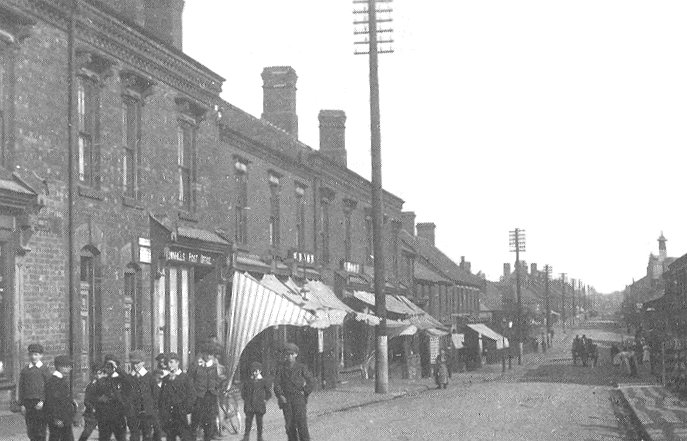
A group of children in High Street, with the
Post Office in the background. From an old postcard. |
|
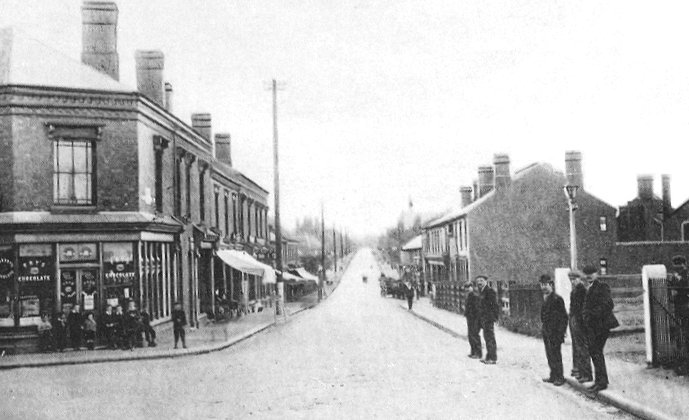
Another view of High Street, with Lichfield
Road on the left. From an old postcard. |
|
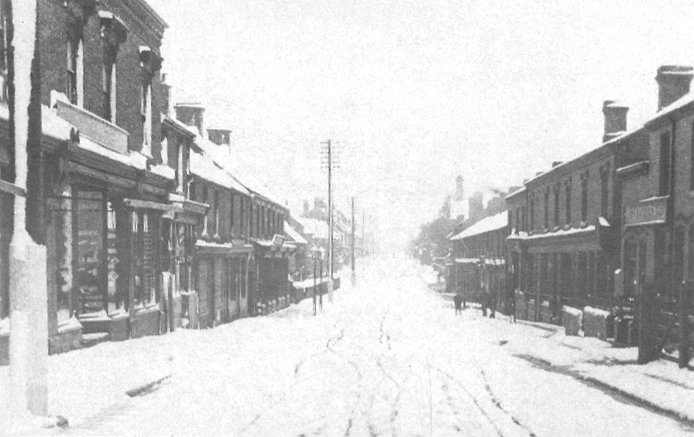
The High Street
under snow in about 1910. From an old
postcard. |
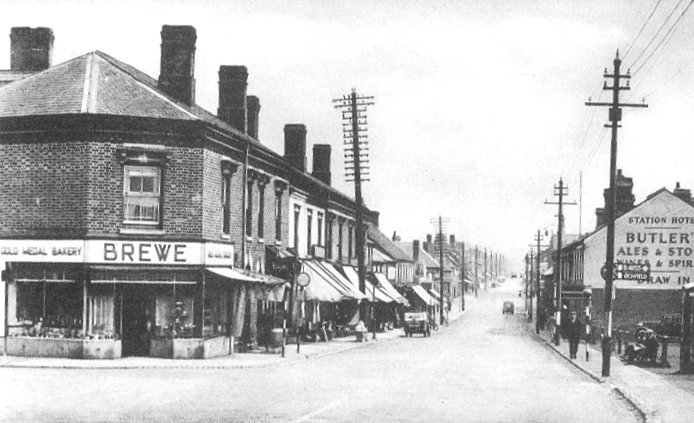
A slightly more recent view of High Street
with Jabez Brewe's shop on the left and the Station Hotel on the
right. From an old postcard. |
| On the opposite side of High Street
behind the Station Hotel was the wakes
ground where for many years Brownhills wakes
were held in the first week of November. In the mid 1890s a horse
racing track stood between the canal and the
railway and during wakes weeks was used for the
Brownhills Colliery Steeplechase. Near the
Station Hotel stood the Royal George public
house which was replaced by the Regent Cinema.
Nearby on the southern side of the street
was Mount Zion Primitive Methodist Church
which opened in 1895, and a few doors away
was the Palace Picture Theatre, built in
about 1912. Early silent films were
accompanied by local musicians playing a piano, a cello and a
violin. During wakes week, variety shows were
held there. On the corner of Pier Street was the
Wesleyan Chapel, which from 1964 was also home to
the Primitive Methodists after the demolition of
Mount Zion Chapel.
In between High Street and the canal stood
the Ogley Hay and Brownhills Gas Company which
opened in 1880 and continued to produce gas
until the early 1930s. The site was near Lindon
Drive where Humphries House stands today In
1913 the first local bus service provided by the
London North & Western Railway began running
between Brownhills and Hednesford. Seven years
later Walsall Corporation began a regular bus
service between Brownhills and Heath Hayes. In
1926 Walsall Corporation began to operate a
regular bus service between Brownhills and
Walsall, via Pelsall.
The local population continued to grow, reaching 16,852
in 1915. |

A London and North Western Railway bus with
its driver and conductor in about 1915. The bus ran between
Brownhills and Chase Terrace. From an old postcard. |
| The
Inter-War Years A
popular local venue, the Memorial Hall in Lichfield Road,
known as 'The Memo', built in memory of those
who lost their lives in the First World War, opened in
1926. Two years later the Regent
picture house opened in High Street.
In 1926 the ownership of
Brownhills Common was transferred to the local
Council, and the eastern end, nearest to the
town centre, was landscaped and new trees were
planted.
The council began a
much-needed house building program that involved
the purchase of large areas of farmland, which were used for the building of council
houses. The scheme, in the mid 1930s, included
the demolition of the slum properties
in Ogley Square, that stood on
the eastern side of St. James Church, on the
corner of Ogley
Hay Road (now Ogley Road) and Mill Road. The
development included the building of The
Wheatsheaf public house that stood on the corner
of the two roads, but was demolished in the late
1990s and replaced with modern housing. Until
demolition in the mid 1930s, the site was
occupied by an earlier pub called The Woodman.
By 1937 there were over 1,000 council houses and
flats in Brownhills Urban District.
Coal mining is a dangerous
occupation, in which accidents can have serious
consequences. In 1861 an accident led to the
deaths of seven miners, including an eleven
year-old
boy, and more recently in October 1930 an
explosion at Grove Colliery killed fourteen
miners, ten of whom were from Brownhills. Grove
Colliery originally belonged to
William Harrison Limited and was one of
the largest and most productive pits in the
area. It opened in about 1870 and by the mid
1920s employed around 1,000 men. At 18 minutes
past nine on the evening of the 1st October,
1930 an explosion occurred in the pit which led
to the deaths. Those who died and causes of
death where as follows:
Died from severe injuries:
John Holland, aged 41, lived in Old Town,
Pelsall
John Hackett, aged 33,
lived in Castle Road, Brownhills
Alfred Heath,
aged 33, lived in Hednesford Road, Brownhills
Harold Smith, aged 38,
lived in Pier Street, Brownhills, and was the
licensee of the Pier Inn
William Whittaker, aged 62,
lived in Fourth Avenue, Brownhills
Died from severe
injuries and carbon monoxide poisoning:
Alfred Boden,
aged 50, lived in
Church Road, Norton Canes
James Malley, aged 44, lived in
Chase Road, Burntwood
John Scoffham,
aged 46, lived in Chase Road, Brownhills
Alec Martin, aged 32, lived in Fourth Avenue, Brownhills
Died from burns and
carbon monoxide poisoning:
Benjamin Corbett,
aged 52, lived in Church
Street, Brownhills
William Robbins, aged 46,
lived in Trinity Cottages,
Watling Street
Richard Howdle, aged 30,
lived in Slough Cottages, Brownhills
John Brownridge,
aged 39, he lived
in Wilkin Road, Brownhills
Died from carbon
monoxide poisoning:
John
Whittaker, aged 44, lived in Field Lane, High
Heath, Pelsall
A funeral service
for the ten miners from Brownhills was held at
St. James Church on 7th October. They
were buried side by side, in the graveyard
behind the church, where a memorial was erected
in their memory. They were buried with full
military honours because six of them had fought
in the First World War.
|
|
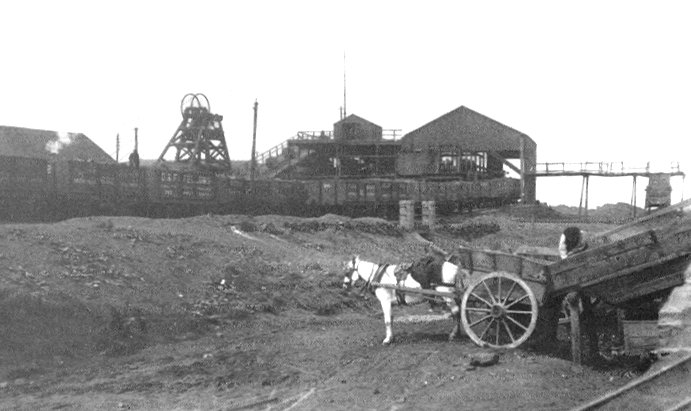
Grove Colliery. From an old postcard. |
|
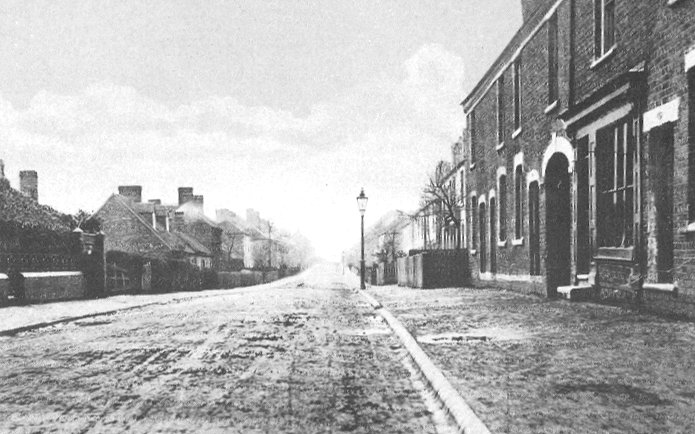
Hednesford
Road in about 1918. From an old
postcard. |
|
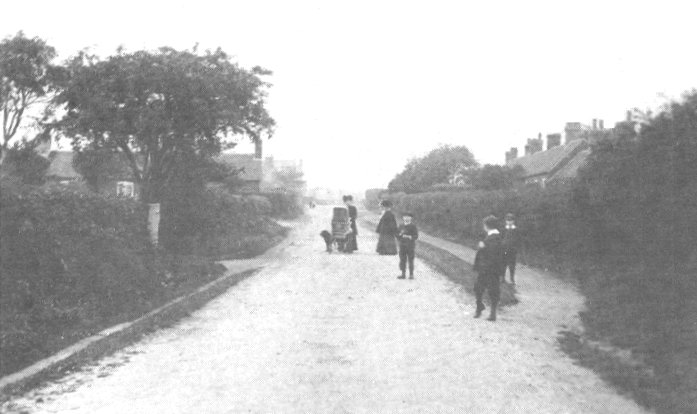
Coppice
Lane in about 1910. From an old
postcard. |
|
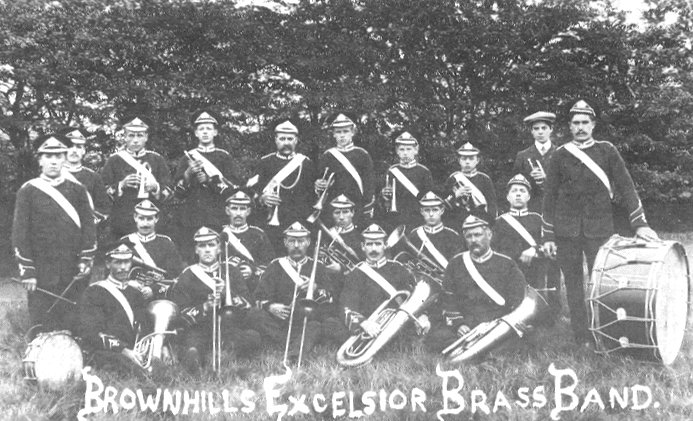
A 1920s
photograph. From an old
postcard. |
|
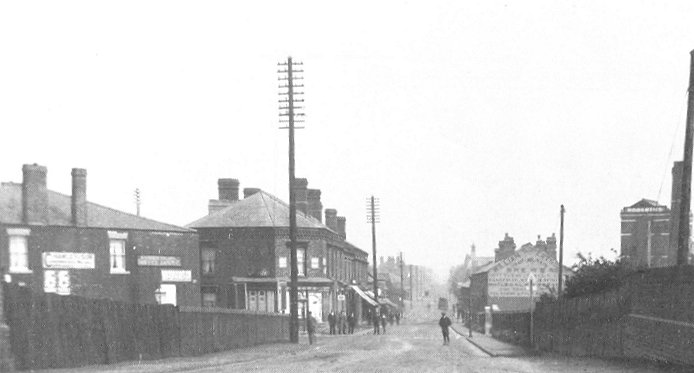
A view of High Street from outside the Council
Building. From an old postcard. |
|
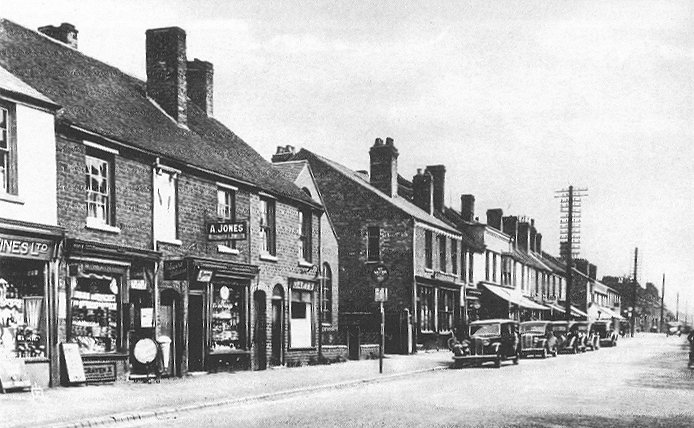
High Street in about 1937. A. Jones was a
watchmaker and jeweller. From an old postcard. |
|
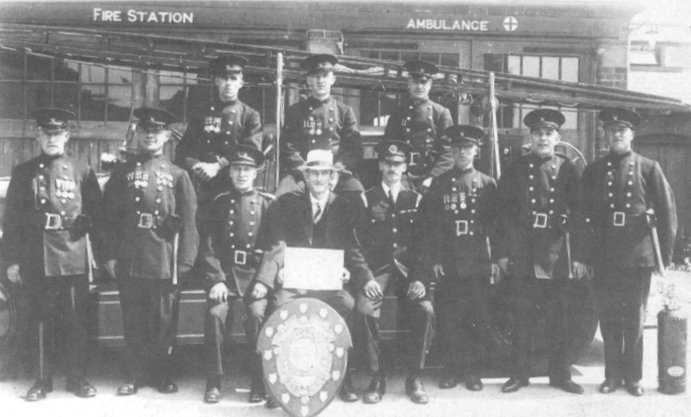
Brownhills
Fire Brigade in about 1940. From an
old postcard. |
|
The Post War
Years
1947 was a year to remember
because of the severely cold winter, one of the
coldest on record, with six weeks of snowfall.
Brownhills was completely cut off by the very deep snow.
This was followed by the worst recorded floods
in the area, which resulted in the drowning of many livestock.
Grove Colliery closed in
1950, and demolition of the surface buildings
and structures was carried out in about 1964.
Coal mining was the dominant industry in the
area, employing much of the working population,
until the 1950s when most of the surviving pits
closed. By the Second World War, many of them
were worked-out. At the end of the war the
government decided to nationalise the industry,
which resulted in the passing of the Coal
Industry Nationalisation Act 1946, and the
formation of the National Coal Board (NCB). When
the local mining industry had gone, a severe
economic decline followed, which resulted in the
closure of many shops in High Street.
In 1966 Brownhills Urban
District merged with Aldridge Urban District to
form the Aldridge and Brownhills Urban District.
This was the result of a recommendation by the
Local Government Commission for England. In 1974
Aldridge and Brownhills Urban District Council
became part of Walsall Metropolitan Borough,
which was formed on 1st April, 1974 following a
local government reorganisation.
Many improvements have been
made since Brownhills became part of Walsall. A
'Townscape Masterplan' has been created to
assist in the town's regeneration, to encourage
the development of shopping facilities, leisure provision,
the refurbishment of run-down properties, and improved
transport facilities, including a new transport
interchange to incorporate Park and Ride
facilities and cycle links to the town centre.
|
|
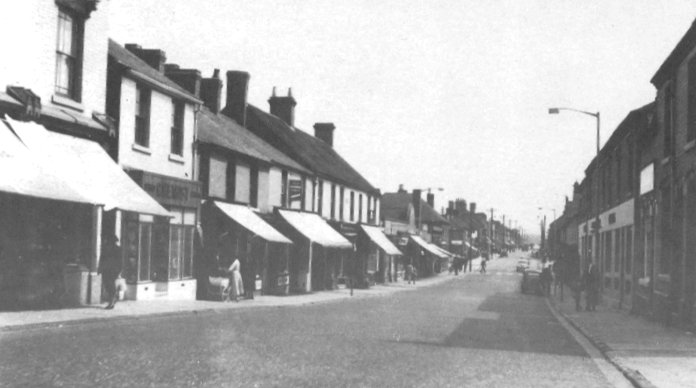
A
1960s view of High Street.
From an old postcard. |
|

The
Brownhills sign in High Street,
designed and produced by John
McKenna. From an old postcard. |
|
Shopping facilities have
greatly improved with the opening of a number of
large retail premises including an Aldi
supermarket, a Tesco supermarket, and the Wilko
store. There are now very few empty shops,
particularly at the northern end of High Street.
Plans have also been made for the redevelopment
of the dilapidated Ravenscourt Precinct, which
opened in 1966.
Brownhills Common and Birch
Coppice are now delightful places to visit with
a good selection of trees and wildlife, and Clayhanger
Common has been designated a Site of Special
Scientific Interest. There is a nature reserve
on the northern part of Brownhills Common and at
Shire Oak Park.
Other leisure actives
include the skate park and multi-sports area at
Holland Park on the edge of the Common. This opened in 2002 and the Brownhills Canoe and Outdoor
Centre which opened in 2006, provides canoeing and
kayaking lessons on the canal.
|
|
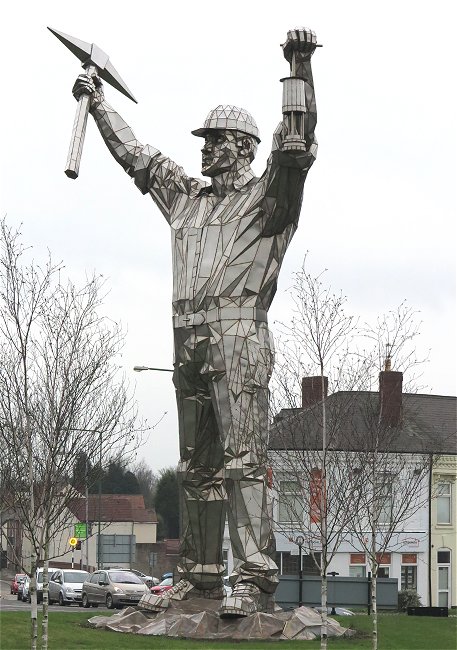
The statue of the
miner, as seen in January 2018. |
There is now a fine
Brownhills sign in High Street and the well
known Brownhills miner statue, both designed and
created by John McKenna.
The galvanised steel
sign was unveiled on 13th December, 2000 and the
wonderful miner statue was erected in May 2006.
The forty feet high statue, which was
commissioned by Walsall Metropolitan Borough
Council in 2005 was floodlit in 2008 to make it
visible at night.
In the same year the statue
was named 'Jigger' after a competition was
organised to choose an official name for the
statue.
The statue is named after Jack 'Jigger'
Taylor who died when the roof of Walsall Wood
pit collapsed in 1951. |
| Another view
of John McKenna's wonderful masterpiece,
also taken in January 2018. |
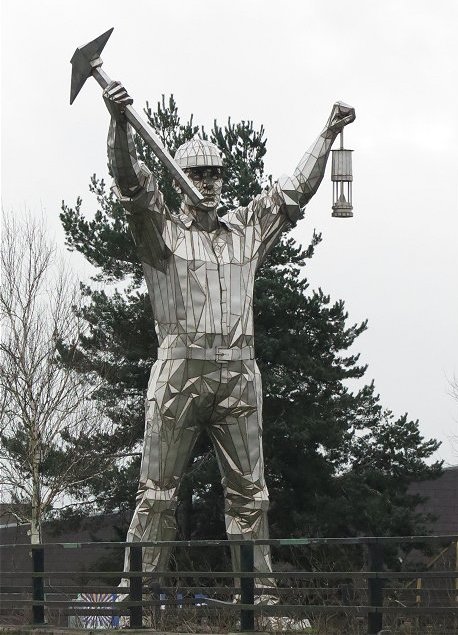 |
 |
Return to
the
previous page |
|